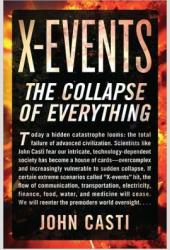


A child born next year will have a reasonable chance of living to see the dawn of the 22nd century should they make it to the age of about 85. While that’s not quite the statistical life expectancy yet in most of the developed world, it’s pretty close especially for women. So while it’s no sure thing, it’s not an unreasonable bet either.
The thing is this though. When we think of the future we tend to see it in a sort of sci-fi world of limitless technological progress when it comes to the general shape of things to come. We may not see the specifics, but we think we know the trend lines. After all, all we have to do is look back on our own past to see how far we’ve come. I was born in 1957. That’s only 58 years ago. Yet the world I live in today little resembles the world I was born into. A glance at the front page of any old newspaper (remember newspapers?) or photograph of any cityscape will quickly confirm that. So imagine being born in 2016 and what the year 2101 might look like, as the 22nd century dawns on Jan. 1, 2101?
Perhaps there is a bit of Buckminster Fuller, the noted American futurist who died in 1983 at the age of 87, after a lifetime spent designing things like Dymaxion houses, cars and maps ™ for his Dymaxion Corporation in Bridgeport, Connecticut, geodesic domes for his Geodesics, Inc., Forest Hills, New York, as well as being the architect between 1965 and 1967 of the United States Pavilion for Expo ’67, the Montreal World’s Fair, in most of my generation.
I still have my cherished copy of The Globe and Mail from Monday, July 21, 1969. I’ve been lugging that paper around – Oshawa, Peterborough, Boston, Durham, North Carolina, Kingston, Ottawa, Yellowknife, Halifax, Sackville, New Brunswick, Thompson, and no doubt a few places I’ve overlooked, for some 46 years now.
The 72-point “going to war” main headline that day – in green yet, at a time when colour printing was rare in newspapers, marked one of humanity’s historic moments: “MAN ON MOON” read that main headline with a bold black second deck subhead: “‘Tranquillity Base here. The Eagle has landed.’”
For a 12-year-old boy, it spoke to my imagination in a way nothing ever had before. The Sixties, which I was too young to fully appreciate, were coming to an end. But this I knew with the moon landing: This was a world, as Expo 67 in Montreal had suggested, where all things technological were truly possible.
The “lede” to the main story, as we quirkly spell lead in newspaperspeak, was elegant in its simplicity. Globe and Mail reporters David Spurgeon and Terrance Wills, in a double bylined story datelined Houston and filed from NASA’s Mission Control, wrote: “Man walked on the moon last night.”
In a “special message” delivered on May 25, 1961 to a joint session of Congress on “urgent national needs,” U.S. President John F. Kennedy had said, “First, I believe that this nation should commit itself to achieving the goal, before this decade is out, of landing a man on the moon and returning him safely to the earth. No single space project in this period will be more impressive to mankind, or more important for the long-range exploration of space; and none will be so difficult or expensive to accomplish….”
Ah, 1969.
To put in perspective just how remarkable the achievement was, the world of 1969 was largely a world without ATMs (they wouldn’t become commonplace until the early 1980s, although the Canadian Imperial Bank of Commerce (CIBC) unveiled its first Canadian automated teller machine called a “24 hour cash dispenser,” on Dec. 1, 1969, just 4½ months after the Apollo 11 moon mission.
The quartz watch was introduced in 1969 and was considered a revolutionary improvement in watch technology because instead of a balance wheel, which oscillated at five beats per second, it used a quartz crystal resonator which vibrated at 8,192 Hz, driven by a battery powered oscillator circuit.
And, of course, the first message transmitted over the Advanced Research Projects Agency Network (ARPANET), the military forerunner to today’s civilian Internet, was sent by UCLA student programmer Charley Kline from an SDS Sigma 7– a computer the size of a one-bedroom apartment – to Bill Duvall, at the Stanford Research Institute in Menlo Park, California on Oct. 29, 1969.
The website FutureTimeline.net, found at http://www.futuretimeline.net predicts that by 2100 “human intelligence is being vastly amplified by AI (Artificial Intelligence), “while Nomadic floating cities are roaming the oceans” and “Emperor penguins face extinction.”
Says FutureTimeline.net: “Ubiquitous, large-scale automation has led to vast swathes of human employees being replaced by virtual or robotic counterparts. Strong AI now occupies almost every level of business, government, the military, manufacturing and service sectors.
“Rather than being separate entities, these AI programs are often merged with human minds, greatly extending the latter’s capability. For instance, knowledge and skills on any subject can now be downloaded and stored directly within the brain. As well as basic information and data, this includes physical abilities. A person can learn self-defence, for example, become an expert in any sport, or be taught to operate a new vehicle, all within a matter of seconds.
“At the dawn of the 22nd century, many of the world’s cities lie partially submerged due to rising sea levels. Despite some attempts to build flood defences, even famous locations – such as New York, London, Hong Kong, Shanghai and Sydney – have been effected. With over 10 per cent of the world’s population living on coastlines, hundreds of millions have been forced to migrate.
“While many citizens have abandoned their homelands, a growing number have adopted a new means of living which does away with national boundaries altogether. This comes in the form of floating, artificial islands – entirely self-sufficient and able to cruise around the world indefinitely.
“These ships provide comfort, safety and security, in stark contrast to the upheaval and chaos experienced by many land dwellers. In addition to a continuous supply of food and freshwater, various facilities are available including virtual reality suites, state-of-the-art android servants/companions, swimming pools, landing pads for anti-grav vehicles and much more. Carefully maintained arboretums with real trees can also be found on board (flora which is becoming increasingly rare these days).
“The world has been transformed by this fusion of people and machines. The vastly greater power of AI means that it has become, at the same time, both master and servant to the human race.
“The benefits of this human-AI merger require the extensive use of implants, however – something which a significant minority of the population still refuses to accept. Compared to transhumans, these non-upgraded humans are becoming like cavemen – thousands of years behind in intellectual development. Unable to comprehend the latest technology, the world around them appears “fast” and “strange” from their increasingly limited perspective. This is creating a major division in society.”
This is a technological but also in some ways disturbingly dystopian view of the not-so-distant future.
But what about if the trip to 2101 and the 22nd century turns out to be not so much like the 20th century and those magnificent men in their flying machines but more like the Dark Ages in Western Europe with the eclipse of civilization that began with the sacking of Rome on Aug. 24, 410 by Alaric and the Visigoths and ending on Nov. 27, 1095 with Pope Urban II’s call of Deus vult!, or “God wills it!”, summoning Christians in Europe to a war against Islamic Saracens in order to reclaim Jerusalem and the Holy Land, as he launched the First Crusade at the Council of Clermont at the Church of Notre-Dame du Port in Auvergne, France?
At the moment, I am in the midst of reading (well actually listening in one case) to two books, one fictional, the other speculative, that point to just how quickly we could be making such a trip back to a modern-day equivalent to the Dark Ages of the 5th to 11th centuries.
New York City writer Emily St. John Mandel’s post-apocalyptic Station Eleven, her fourth novel, published last year, is centered around the fictional but not so implausible in the-world-after-SARS (severe acute respiratory syndrome) in 2003 and the H1N1 influenza pandemic of 2009 “Georgia Flu,” a flu pandemic so lethal and named after the former Soviet republic that, within weeks, most of the world’s population has been killed. Station Eleven, which was a finalist for a National Book Award and the PEN/Faulkner Award, won the 2015 Arthur C. Clarke Award for best science fiction novel of the year for the British Columbia-born writer. It all begins when the character of 51-year-old Arthur Leander has a fatal heart attack while on stage performing the role of King Lear at Toronto’s Elgin Theatre.
As the novel picks up some 20 years later, “there is no more Toronto,” Sigrid Nunezsept noted in the Sept. 12, 2104 New York Times book review “Shakespeare for Survivors.” In fact, “There is no Canada, no United States. All countries and borders have vanished. There remain only scattered small towns.”
Airplanes are permanently grounded and used as cold storage facilities. There are no hospitals or clinics.
But there is the “Travelling Symphony” made up of “20 or so musicians and actors in horse-drawn wagons who roam from town to town in an area around the shores of Lakes Huron and Michigan,” Nunezsept writes. “At each stop the Symphony entertains the public with concerts and theatrical performances – mostly Shakespeare because, as the troupe has learned, this is what audiences prefer.”
While mathematician and complexity scientist John Casti suffered his own self-inflicted plague of plagiarism problems elsewhere more than a decade ago, his 2012 book, X-Events: The Collapse of Everything, which looks at scientific modelling and prediction computer simulation as to how social “mood” can affect future trends and extreme events, is nonetheless a clarion warning as to how easy it would be to slip suddenly into a new Dark Ages.
Casti’s book looks at how the global food supply system could collapse, the “digital darkness” that would come from a widespread and prolonged failure of the Internet, what a continent-wide electromagnetic pulse (EMG) would do to electronics, and how we may have reached peak oil in 2000 (although not immediately apparent perhaps with West Texas Intermediate crude oil at the benchmark price of about US$35 per barrel, a seven-year low) and how any of those scenarios leave us vulnerable in overly complex technological societies to an “X-event” that would send us back to a pre-modern world – and again, a world without air or other long-distance travel – virtually overnight.
You can also follow me on Twitter at: https://twitter.com/jwbarker22
